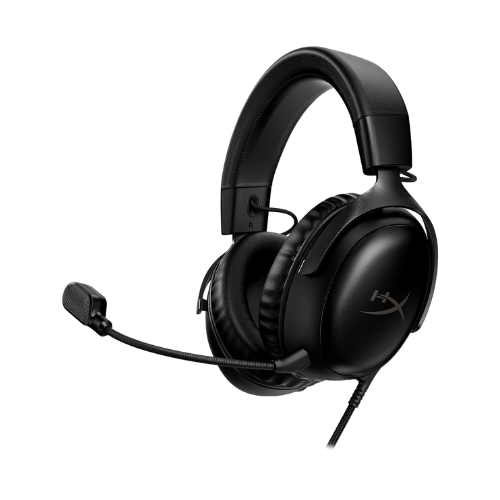Key Takeaways
- The HyperX Cloud III wired headset provides clear and full-bodied audio with DTS Headphone X compatibility, offering an immersive gaming experience.
- Compared to its predecessor, the Cloud III offers improved comfort and microphone quality, with a less-aggressive noise reduction that allows for clearer communication with teammates.
- The DTS Headphone:X compatibility of the Cloud III delivers 3D spatial audio, enhancing the audio experience for explosive action, atmospheric horror, and energetic soundtracks across various gaming platforms.
Sound is a big part of the gaming experience. Whether you’re engrossed in a tense firefight or issuing commands to your squad, clarity is critical. The comfortable HyperX Cloud III wired headset achieves clear, full-bodied audio with DTS Headphone X compatibility and an ultra-clear 10mm microphone.
Having used HyperX products before, specifically the Cloud II headset, I was confident the Cloud III would be of good quality. What I didn’t expect was a noticeable improvement over its predecessor, especially considering on paper, the two are nearly identical. The Cloud III is equipped with the same 53mm neodymium magnet dynamic divers and a very similar frequency. Still, the Cloud III is a noticeable improvement in comfort and, most surprisingly, in the microphone. Less-aggressive uni-directional noise reduction cuts down on background sounds without muddying the audio, allowing your teammates to hear you clearly and not just your cat meowing or the mind-numbing hum of a fan. What really elevates the Cloud III experience is DTS Headphone:X compatibility, which simulates surround sound for 3D spatial audio. It’s a wild, immersive ride that elevates explosive action, atmospheric horror, and energetic soundtracks whether you’re playing on mobile, PC, PS5, Nintendo Switch, or Xbox Series X & S.
As good as the Cloud III is compared to its predecessors and similar models, I can’t quite say it’s perfect. The earpads could be firmer, but the most notable issue is the build quality, which feels flimsy despite being a metal frame.


HyperX Cloud III
HyperX Cloud III is a mid-range headset dishing out high-quality audio. Equipped with DTS Headphone:X, its 3D spatial audio capabilities deliver cinema-like quality and pull you right into the action. Save for a few design flaws, Cloud III stands out among higher-priced competitors.
- What’s Included
- USB dongle, detachable microphone
- Compatibility
- Mobile, PC, PS5, Switch, Xbox Series X/S
- Weight
- .71lb (.32kg)
- Ear Cushions
- Leatherette
- Driver
- Dynamic, 53mm with Neodymium magnets
- Frequency Response
- 10Hz – 21kHz
- Microphone
- Electret condenser microphone
- Noise Cancellation
- Uni-directional
- 3D spatial audio is very accurate
- DTS Headphone:X delivers cinema-quality sound
- Microphone is very crisp and clear
- Some components feel cheap
- Leatherette earpads get hot over time
- Windscreen not included for microphone
Design and Fit
Comfort is one of the first things I noticed with HyperX’s Cloud III wired headset. I didn’t expect a noticeable improvement from the Cloud II, but there is a little more padding in the memory foam ear cushions. It’s a subtle difference, but it’s there. Most importantly, I never felt like my head was being squeezed, and wearing the headset for over an hour wasn’t uncomfortable—save for light sweating.
Leatherette is an interesting choice of material for a device that’s meant to be used for hours at a time. The synthetic leather is less breathable than its authentic counterpart and basic fabric, so expect to sweat more. I tested the Cloud III in the height of a Las Vegas summer, and it was a little warmer to use than a headset like Razer’s Kaira Pro, which puts a piece of fabric between your ears and the cushions.
Different from the Cloud II, this wired headset features volume and mute controls on the earpieces rather than a control unit on the cord. It’s far more convenient as you can make the necessary adjustments without having to fish for the right spot on the cord.
Sound and Microphone Quality
Whether you use the attached 3.5mm cable plugged into your Xbox controller or the detachable USB dongle for your PC, the Cloud III delivers peak performance. Though the headset uses the same drivers as its predecessor, HyperX tweaked them a little for a fuller, crisper sound. I did notice a subtle decrease in the bass and treble quality, but the overall audio was quite a bit better. I do have to credit some of that to DTS Headphone:X.
DTS Headphone:X allows the Cloud III to offer 3D spatial audio, and it can be a game changer. Depending on the game you’re playing, that sound stage emulation promotes sound localization so you can pinpoint the direction an audio cue is coming from. I had way too much fun playing “Dead Space” and having a gut reaction to every hiss of the USG Ishimura or knowing exactly where a necromorph was charging from.
“Gears 5” offered a different experience, fully pulling me into every Locust encounter with cinematic-grade audio. Bullets peppered the floor around me as spatial audio brought the war zone into my office.
Even games that don’t support or benefit from spatial audio sounded good through the Cloud III’s 53mm drivers. No audio seemed lost, even when my ears were flooded with a mix of multiplayer banter and explosions.
The Best Microphone on the Market?
In-game audio is only half the Cloud III’s functions, and the microphone doesn’t disappoint. It doesn’t come with a windscreen, and while I initially thought that odd, after a few test recordings, it’s clearly not needed. HyperX improved upon the Cloud II’s microphone, focusing primarily on noise cancelation.
In Cloud III’s predecessor, the background noise reduction was a little too aggressive. It wound up muddying the audio a little and sometimes inadvertently cutting out my voice. Cloud III was more effective in finding that sweet spot between minimizing background noise without altering the input quality.
The sturdy, detachable electret condenser microphone is sure to keep you in touch with your teammates even in the most frantic of firefights.
The NGENUITY App
HyperX’s NGENUITY app (available on Windows) is a necessary companion if you want to tweak Cloud III’s settings. When it’s working properly and not glitching out, the app puts you in control of an extensive equalizer and the DTS:X spatial sound settings. It’s an otherwise simple app to navigate, and it gives you access to your full library of HyperX devices. I ran into a few bugs along the way, specifically with NGENUITY failing to recognize both the Cloud III and the Pulsefire Haste 2 wireless mouse I have. If the app worked a little more consistently, it would be a more suitable companion to Cloud III and capture HyperX’s expected quality. Otherwise, it was easy to navigate, and changing the headset’s properties was a user-friendly process.
How Cloud III Stacks Up to Competitors
There is no shortage of headsets available for gamers. Razer, Corsair, Audeze, Audio-Technica, and, of course, HyperX are just a handful of the brands out there creating unique audio experiences. While there’s some pretty hefty competition in those names, the HyperX Cloud III does stack up well against them.
If Razer’s BlackShark V2 were more expensive, it’d be easier to recommend HyperX’s latest headset outright, but the two are so close in specs and performance that it comes down to comfort. And in that category, the BlackShark V2 excelled with the breathable weave Flowknit memory foam ear cushions that reduced sweat better than the Cloud III.
Should You Buy the HyperX Cloud III Wired Headset?
The HyperX Cloud III could have very well been a marginal upgrade over the Cloud II. Thankfully, there’s enough here to warrant opting for the newer model. While the drivers are no different on paper, HyperX put more work into Cloud III’s dynamic drivers to provide you with crisper, fuller-bodied audio. There was a slight noticeable dip in audio quality when it came to bass and treble, but it wasn’t enough to take away from the overall experience.
There are several ways to connect the Cloud III, from the standard 3.5mm audio jack to an included USB dongle. Regardless of how your console or PC dictates how you connect the headset, you won’t see a difference in quality. Whether I was battling horrific space threats on my Xbox or exchanging grenades on my PC, the audio felt like a character of its own. It pulled me into the on-screen action and enhanced the experience with 3D spatial audio via DTS Headphone:X. It was marginally annoying initially to use DTS on the Xbox, as it required a download of the dedicated DTS app, but it was worth it in the long run.
Cloud III’s biggest pitfall is its physical build. Leatherette earpads were not the best choice and got hot over time. While the metal frame was sturdy and comfortable and clamped the audio device to my head, some components felt cheap. In particular, two plastic covers at the end of the headband padding didn’t quite match the quality expected from a HyperX device and the headphones themselves felt like a low-grade option. Cloud III is anything but low-grade, though, and its physical impediments didn’t diminish the audio experience.


HyperX Cloud III
HyperX Cloud III is a mid-range headset dishing out high-quality audio. Equipped with DTS Headphone:X, its 3D spacial audio capabilities deliver cinema-like quality and pull you right into the action. Save for a few design flaws, Cloud III stands out amongst higher-priced competitors.







